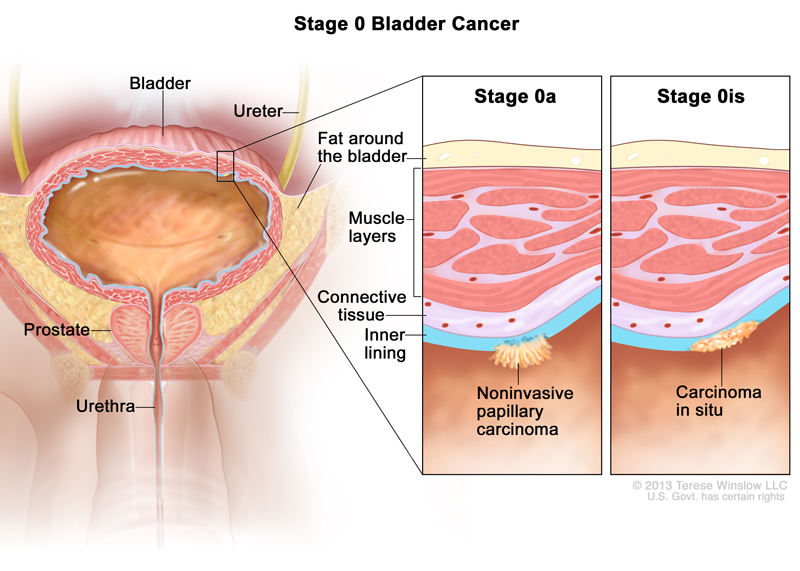Stage 0 Bladder Cancer ICD 10 is C67.0.
Tap “Watch Now” for an easy-to-understand overview of Stage 0 Bladder Cancer.
- Stage 0 Bladder Cancer
Stage 0a
Stage 0a Bladder Cancer diagnosis means that your Bladder Cancer is found only on the lining, inside the bladder and consists of abnormal cells with long thin growths that extend into the bladder sac as shown here in yellow.
The cancer has not spread to your bladder muscle, to the area around your bladder or to any other organ.
What Tests Will I Need and Why?
Urine, Blood and Imaging tests may be needed to understand your general health, confirm your diagnosis and determine your cancer stage.
Tissue analysis is also typically done through a biopsy to identify the cancer cell type, which is critical to finding the best treatment option for you.
If your treatment team has not already performed tests to determine your cancer’s features, please ask your doctor when these tests will be performed.
Re-read this summary as needed and then tap, “Compare My Treatment Options Now“. Our unique Comparison Page will help you understand your FDA-approved treatment options including, who can help you pay for your treatment, where and how each is given and what side-effects you may experience.

Stage 0is
Stage 0is Bladder Cancer diagnosis means that the Bladder Cancer is flat and found only on the inner lining of your bladder as shown here in the right image.
The cancer has not spread to your bladder muscle, the area around your bladder or any other organ.
What Tests Will I Need and Why?
Urine, Blood and Imaging tests may be needed to understand your general health, confirm your diagnosis and determine your cancer stage.
Tissue analysis is also typically done through a biopsy to identify the cancer cell type, which is critical to finding the best treatment option for you.
If your treatment team has not already performed tests to determine your cancer’s features, please ask your doctor when these tests will be performed.
Re-read this summary as needed and then tap, “Compare My Treatment Options Now“. Our unique Comparison Page will help you understand your FDA-approved treatment options including, who can help you pay for your treatment, where and how each is given and what side-effects you may experience.

National Institute of Health/ treatment-bladder
Recommended Bladder Cancer Videos

Understanding Your Bladder Cancer
An Easy to Follow Overview

Understanding Your Cancer Diagnosis
What Are Your Goals & More

How Cancer Spreads
Metastatic = Advanced

Diagnosing Your Cancer
How Does a CT Scan Work?

Diagnosing Your Cancer
How Does a PET Scan Work?

Exercise! You Can Do It
Reducing Side Effects & More
Commonly Searched Questions
Stage 0 Bladder Cancer Symptoms
- Blood in urine
- Urinating multiple times in a night
- Pain while urinating
- Difficulty urinating with a low-pressure stream of urine
Source: Cancer.org
Stage 0 Bladder Cancer Treatment
- Surgery to remove the Bladder Cancer
- Surgery to remove a part of the bladder or the whole bladder
- Chemotherapy after surgery given directly into the bladder
- Immunotherapy to help your immune system identify and kill the Bladder Cancer. BCG is the most commonly used immunotherapy for Stage 0.
Source: Cancer.gov
Stage 0 Bladder Cancer Survival Rate
Source: Cancer.gov
Stage 0 Bladder Cancer Prevention
Source: Cancer.gov
Stage 0 Bladder Cancer Definition
Source: Cancer.org
Stage 0 Bladder Cancer Recurrence Rate
Source: Cancer.gov














